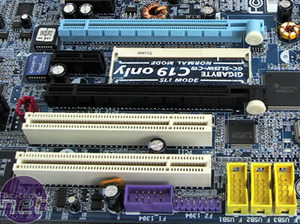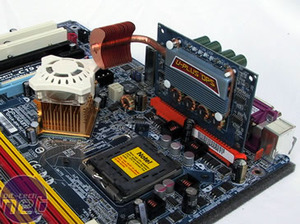MSI P4N Diamond & Gigabyte GA-8N-SLI
July 29, 2005 | 14:36

Whilst the SLI switch isn’t digital like MSI’s, and it is more annoying to have to go into your case and remove your graphics card to get enough space to swap it over, considering you’ll only probably ever do it at most a couple of times in the lifetime of the board it’s not really much of an issue.

 Gigabyte employ their usual patented Dual BIOS technology to prevent bad BIOS flashes and their U-Plus DPS to provide 8 phase power to provide extra clean power for those hungry Prescott CPUs. Normally motherboards carry 4 phase power, like the Gigabyte does without the U-Plus DPS expansion; however 8 phase power regulation causes less stress on components and more distributed heat output making them last longer and overclock better because you have more headroom to play with.
Gigabyte employ their usual patented Dual BIOS technology to prevent bad BIOS flashes and their U-Plus DPS to provide 8 phase power to provide extra clean power for those hungry Prescott CPUs. Normally motherboards carry 4 phase power, like the Gigabyte does without the U-Plus DPS expansion; however 8 phase power regulation causes less stress on components and more distributed heat output making them last longer and overclock better because you have more headroom to play with.
Also, because normally the heat is transmitted through the main PCB it means lower CPU temperatures. The provided U-Plus DPS uses heat pipe technology and a small quantity of copper fins to keep it cool and also has 4 blue LED’s to display current load and thus is an indicator of CPU usage.
All in all this shouldn’t disappoint anyone but the most hardcore minority of overclockers and phase-change users. Annoyingly, if you want to “unlock” a comprehensive set of performance features, you have to hit Ctrl+F1 in the main menu. We can’t understand why you have to do this, considering you have potentially more damaging voltage options as standard.
The advanced options contain the M.I.B.2 (Memory Intelligent Tweaker) where the BIOS has a set of pre-determined DIMM types that supposedly optimises the memory bandwidth by up to 10% depending on the module types. A set of options is available listing the most popular memory manufacturers and you can choose which corresponds to the memory you are using so it can automatically tweak the BIOS settings to provide better performance.
Gigabyte also includes their own on-the-fly overclocking technology in the form of their C.I.A.2 (CPU Intelligent Accelerator). American acronym stealing antics aside, this BIOS option allows a pre-defined set of overclocking options from “Cruise” at 5-7% to “Full Thrust” at “17-19%. Whether your system can actually handle up to 17-19% is another matter, but it’s a good way for users who are less familiar with the art of overclocking to get into it.
The system determines your CPU load and overclocks to the pre-determined setting on detection of a constant loading. This means that your PCs performance will improve when it is required; when the additional power isn't required, the components are clocked down to extend the life of your components.


Also, because normally the heat is transmitted through the main PCB it means lower CPU temperatures. The provided U-Plus DPS uses heat pipe technology and a small quantity of copper fins to keep it cool and also has 4 blue LED’s to display current load and thus is an indicator of CPU usage.
The BIOS:
Gigabyte uses a standard Award BIOS with the usual features allowing the user to tweak all of the onboard components as necessary. Gigabyte's M.I.T. (Motherboard Intelligent Tweaker) is their overclocking and tweaking section providing adjustment in CPU bus, memory bus, PCI-Express frequency and LDT multiplier as well as voltage adjustments for memory (+0.7v max), PCI-Express, memory and SATA (+0.3v max), as well as CPU up to 1.6v. Memory speed selection can either be front side bus linked or separate as long as it conforms to a reasonably large standard set of dividers.All in all this shouldn’t disappoint anyone but the most hardcore minority of overclockers and phase-change users. Annoyingly, if you want to “unlock” a comprehensive set of performance features, you have to hit Ctrl+F1 in the main menu. We can’t understand why you have to do this, considering you have potentially more damaging voltage options as standard.
The advanced options contain the M.I.B.2 (Memory Intelligent Tweaker) where the BIOS has a set of pre-determined DIMM types that supposedly optimises the memory bandwidth by up to 10% depending on the module types. A set of options is available listing the most popular memory manufacturers and you can choose which corresponds to the memory you are using so it can automatically tweak the BIOS settings to provide better performance.
Gigabyte also includes their own on-the-fly overclocking technology in the form of their C.I.A.2 (CPU Intelligent Accelerator). American acronym stealing antics aside, this BIOS option allows a pre-defined set of overclocking options from “Cruise” at 5-7% to “Full Thrust” at “17-19%. Whether your system can actually handle up to 17-19% is another matter, but it’s a good way for users who are less familiar with the art of overclocking to get into it.
The system determines your CPU load and overclocks to the pre-determined setting on detection of a constant loading. This means that your PCs performance will improve when it is required; when the additional power isn't required, the components are clocked down to extend the life of your components.

MSI MPG Velox 100R Chassis Review
October 14 2021 | 15:04





Want to comment? Please log in.